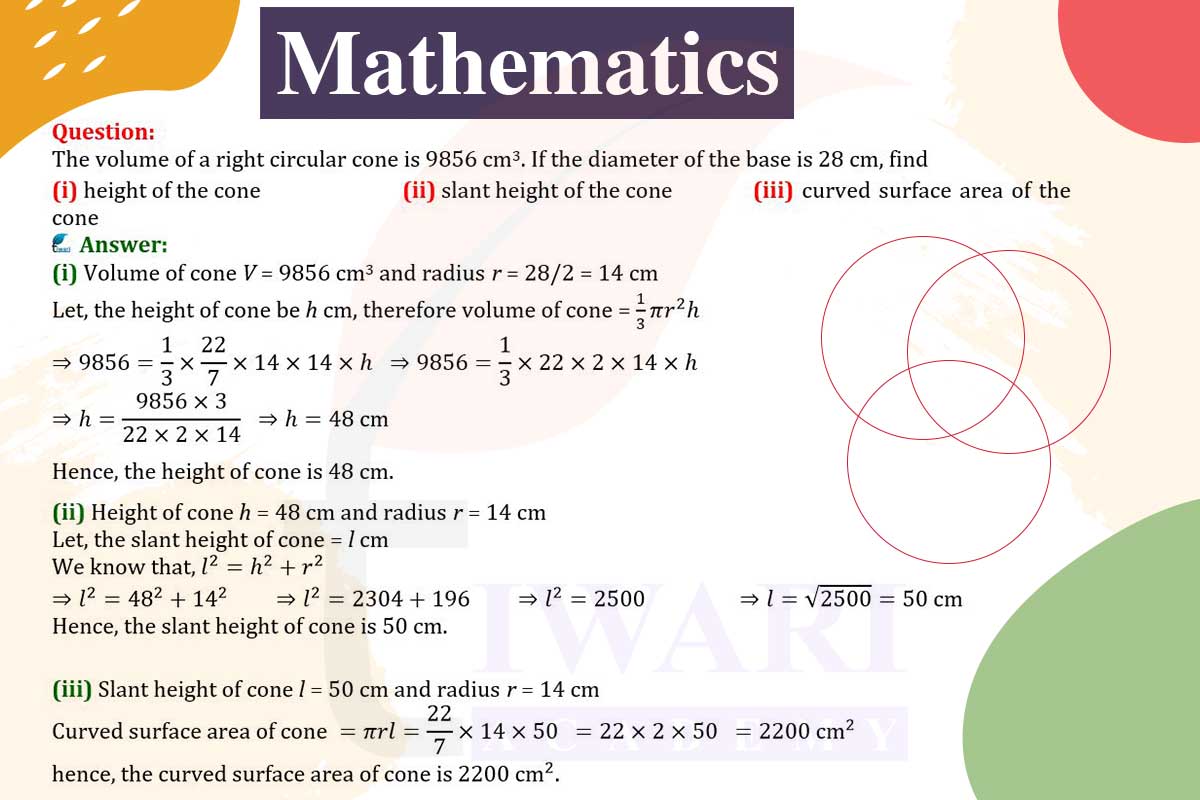To find the dimensions and surface area of a cone with a volume of 9856 cm³ and a base diameter of 28 cm:
(i) Height: The volume formula V = (1/3)πr²h is rearranged to h = 3V/πr². With V = 9856 cm³ and radius r = 14 cm (half of 28 cm), the height h is calculated.
(ii) Slant Height: Using Pythagoras’ theorem, l = √[r² + h²], the slant height is found using the radius and calculated height.
(iii) Curved Surface Area: It’s calculated using CSA = πrl with the radius and slant height.
These calculations provide the cone’s height, slant height, and curved surface area.

Let’s discuss in detail
Cone Dimension Calculations
Determining various dimensions of a cone, such as height, slant height, and surface area, from given parameters like volume and diameter, is a fundamental exercise in geometry. A right circular cone is a three-dimensional shape with a circular base that narrows smoothly to a point, known as the apex. The volume of a cone is a key attribute that quantifies the space it occupies. When the volume and the diameter of the base are known, it is possible to derive other important dimensions of the cone. This process involves applying geometric formulas and principles to solve for the unknown measurements.
Calculating the Height of the Cone
The first step is to calculate the height of the cone. The volume of a cone is given by the formula V = (1/3)πr²h, where V is the volume, r is the radius of the base, and h is the height. Given the volume (9856 cm³) and the diameter of the base (28 cm), the radius r is half the diameter, i.e., 14 cm. Rearranging the formula to solve for h, we get h = 3V/πr². Substituting the known values, we can calculate the height of the cone.
Determining the Slant Height of the Cone
Once the height is known, the next step is to find the slant height of the cone. The slant height is the length of the line segment from the apex of the cone to the edge of the base. It can be calculated using Pythagoras’ theorem, which states that in a right-angled triangle, the square of the hypotenuse (slant height) is equal to the sum of the squares of the other two sides (radius and height). The formula is l = √[r² + h²], where l is the slant height.
Computing the Curved Surface Area of the Cone
The curved surface area (CSA) of a cone is another important dimension, especially in applications involving material usage or decoration. The CSA of a cone is calculated using the formula CSA = πrl, where r is the radius and l is the slant height. This area represents the outer surface of the cone, excluding the base. After finding the radius and slant height, these values are substituted into the formula to determine the CSA.
Applications of Cone Calculations
These calculations are not just academic exercises but have practical applications in various fields. For instance, in engineering and architecture, knowing the dimensions of a cone is crucial for designing structures or components. In manufacturing, these calculations help in material estimation and cost analysis. Even in everyday scenarios, such as crafting or cooking, understanding the dimensions of a conical shape can be very useful. The ability to calculate these dimensions from limited information demonstrates the power and utility of geometric principles.
The Significance of Geometric Problem-Solving
In conclusion, solving for the dimensions of a cone from given parameters like volume and diameter showcases the application of geometry in solving real-world problems. It highlights the importance of understanding geometric formulas and their rearrangements. These calculations not only provide the necessary dimensions but also enhance our understanding of spatial relationships in geometric figures. Such problem-solving skills are essential in various professional fields and everyday life, emphasizing the practical importance of geometry.
Discuss this question in detail or visit to Class 9 Maths Chapter 11 for all questions.
Questions of 9th Maths Exercise 11.3 in Detail

